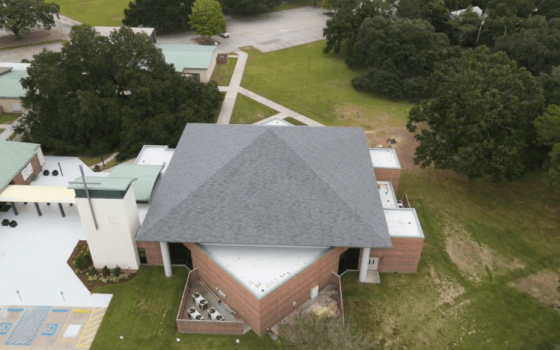Commercial Roofing Materials





Commercial Roofing Materials

Commercial Roofing Materials

Commercial Roofing Materials
Types of Materials
Mod-Bit
Modified bitumen (mod bit) roofing is a popular choice for flat or low-slope roofs, known for its durability, versatility, and ease of installation. It is a type of asphalt-based roofing system that incorporates polymer modifiers to enhance its performance.
TPO
Thermoplastic Polyolefin (TPO) roofing is a single-ply roofing membrane widely used in commercial and industrial applications due to its excellent performance characteristics and cost-effectiveness. TPO is known for its energy efficiency, durability, and ease of installation.
Types of Mod-Bit
Modified Bitumen (Mod Bit)
SBS (Styrene-Butadiene-Styrene)
– Adds rubber-like flexibility to the asphalt, enhancing its ability to withstand temperature variations.
– Often installed with cold adhesive or hot asphalt, but can also be torch-applied.
APP (Atactic Polypropylene)
– Adds plastic-like properties to the asphalt, improving its resistance to UV radiation and high temperatures.
– Typically installed using a torch to melt the material and bond it to the roof surface.
1. Durability: Modified bitumen is highly resistant to weathering, UV radiation, and physical damage, making it suitable for various climates.
2. Flexibility: The polymer modification improves flexibility, allowing the material to expand and contract with temperature changes without cracking.
3. Waterproofing: Provides excellent waterproofing properties, ensuring a watertight seal and protecting the building from leaks.
4. Ease of Installation: Can be installed using different methods, such as torch-applied, cold-applied, self-adhered, or hot-mopped, offering versatility in application.
5. Maintenance: Generally low-maintenance, requiring regular inspections and minor repairs to ensure longevity.
1. Torch-Applied: Involves heating the underside of the membrane with a torch to melt the bitumen and adhere it to the roof surface.
2. Cold-Applied: Utilizes adhesive products to bond the membrane to the roof without the need for heat.
3. Self-Adhered: Features a peel-and-stick application method, simplifying installation and reducing the risk of fire hazards.
4. Hot-Mopped: Uses hot asphalt to adhere the membrane, similar to traditional built-up roofing systems.
1. Base Sheet: The initial layer, often mechanically fastened or adhered to the roof deck.
2. Ply Sheets: Multiple layers of reinforced modified bitumen sheets, providing strength and durability.
3. Cap Sheet: The top layer, typically granule-surfaced to provide UV protection and aesthetic appeal.
4. Flashing: Critical components around roof penetrations and edges to ensure a watertight seal.
1. Versatility: Suitable for a wide range of applications, including commercial, industrial, and residential buildings.
2. Energy Efficiency: Available in reflective “cool roof” formulations that reduce heat absorption and lower cooling costs.
3. Cost-Effective: Offers a good balance of performance and cost, making it an economical choice for flat or low-slope roofs.
4. Repairability: Damage can often be repaired without the need for complete roof replacement, extending the roof’s lifespan.
– Regular inspections to check for signs of wear, damage, or ponding water.
– Clearing debris from the roof surface and drainage systems to prevent water accumulation.
– Promptly addressing minor issues, such as small tears or blisters, to prevent more significant damage.
TPO
Thermoplastic Polyolefin (TPO)
- Energy Efficiency: TPO roofing is highly reflective, which helps reduce heat absorption and lowers cooling costs. This makes it an attractive option for “cool roof” applications.
- Durability: TPO membranes are resistant to UV radiation, chemical exposure, and punctures, offering long-term durability and protection.
- Seam Strength: The heat-welded seams of TPO are typically stronger than the material itself, providing excellent waterproofing and reducing the risk of leaks.
- Flexibility: TPO remains flexible in both hot and cold temperatures, accommodating building movement and thermal expansion without cracking.
- Eco-Friendly: TPO roofing is often recyclable, contributing to reduced environmental impact.
- Mechanically Attached: The membrane is fastened to the roof deck using screws and plates, allowing for quick and easy installation.
- Fully Adhered: The membrane is bonded to the substrate using adhesive, providing a smooth appearance and enhanced wind uplift resistance.
- Ballasted: The membrane is held in place by a layer of ballast, such as river rock or pavers, reducing the need for fasteners or adhesives.
- TPO Membrane: The primary waterproofing layer, available in various thicknesses (typically 45 to 80 mils). It is usually white or light-colored for high reflectivity.
- Insulation: Installed beneath the membrane to improve energy efficiency and provide a stable substrate.
- Cover Board: A rigid layer placed over the insulation to protect it and provide a smooth surface for the TPO membrane.
- Fasteners and Adhesives: Used to secure the membrane to the roof deck or insulation.
- Flashing: Ensures watertightness around roof penetrations and edges.
- Cost-Effective: TPO roofing offers a good balance of performance and affordability, making it a popular choice for many building types.
- Ease of Installation: Available in wide rolls, TPO membranes can be quickly installed, reducing labor costs and installation time.
- Reflectivity: High reflectivity helps lower building cooling costs and contributes to energy savings.
- Low Maintenance: TPO roofs require minimal maintenance, with periodic inspections and cleaning to ensure long-term performance.
- Versatility: Suitable for various roof designs, including flat, low-slope, and some steep-slope applications.
- Regular Inspections: Conduct periodic inspections to check for signs of damage, such as punctures, tears, or seam issues.
- Cleaning: Clean the membrane surface to remove dirt, debris, and algae, which can affect reflectivity and performance.
- Repairs: Address any minor issues promptly to prevent them from developing into more significant problems. Heat welding can be used to repair damaged areas effectively.





